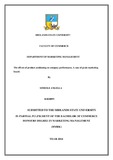Please use this identifier to cite or link to this item:
https://cris.library.msu.ac.zw//handle/11408/2319Full metadata record
| DC Field | Value | Language |
|---|---|---|
| dc.contributor.author | Sithole, Angella | - |
| dc.date.accessioned | 2017-06-29T12:51:09Z | - |
| dc.date.available | 2017-06-29T12:51:09Z | - |
| dc.date.issued | 2014-04 | - |
| dc.identifier.uri | http://hdl.handle.net/11408/2319 | - |
| dc.description.abstract | The research was meant to assess the effects of product positioning on company performance. A case study of Grain Marketing Board Zimbabwe was used. The objectives of this study were to assess consumers brand association of the Silo products, to evaluate the impact of Silo brand communication on brand awareness and to assess if Silo brand identity matches consumer perceptions. Literature gaps were identified on the areas like the match between brand identity and consumer perceptions. There were very few scholars that did the research on this area. In this research, exploratory and descriptive research design was used. The researcher used non probability sampling techniques which were convenience sampling and judgmental sampling. Judgmental sampling was used in the administering of questionnaires to employees while convenience was used while administering questionnaires to customers. A sample of 180 respondents was used and it contains 5 management, 5 wholesalers, 19 employees, 19 retailers and 132 individual customers. Consumers have a negative perception towards the Silo brand. Responses from the questionnaires show that the Silo brand is associated with poor quality and the company relies heavily on salespeople and exhibitions to communicate the Silo brand to the market. Brand awareness of the Silo brand is poor since it was noted that customers could not distinguish the Silo brand logo from competitors. Moreover the Silo brand identity mismatches with consumer perceptions. The perceptions of the customers’ shows that customers have no trust in G.M.B products and that they associate the brand with poor quality. Moreover they said the brand has no unique products and also that the products have short shelf life. Also they complained that even their unique selling proposition is not matching with consumer perceptions. The researcher recommends that G.M.B should run away from the features/attributes approach of product positioning which emphasize a lot on the unique features of products and services and should rather adopt competitor’s approach of product positioning where it deliberately compares itself to competitors as a means of gaining the competitive advantage. | en_US |
| dc.language.iso | en | en_US |
| dc.subject | Product positioning | en_US |
| dc.title | The effects of product positioning on company performance: a case of grain marketing board. | en_US |
| item.fulltext | With Fulltext | - |
| item.grantfulltext | open | - |
| item.languageiso639-1 | en | - |
| Appears in Collections: | Bachelor Of Commerce Marketing Management Honours Degree | |
Files in This Item:
| File | Description | Size | Format | |
|---|---|---|---|---|
| Sithole A..pdf | Full Text | 958.09 kB | Adobe PDF |  View/Open |
Page view(s)
192
checked on Nov 23, 2025
Download(s)
124
checked on Nov 23, 2025
Google ScholarTM
Check
Items in MSUIR are protected by copyright, with all rights reserved, unless otherwise indicated.



